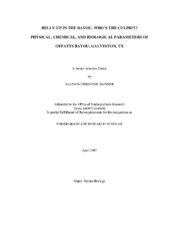| dc.description.abstract | Offatts Bayou is an embayment in the Galveston Bay complex on the upper Texas coast. The bayou is approximately 4.8 km long with a maximum width of 1 km, and an average depth of approximately 5 m. A small created lake (Lake Madeline) is connected to Offatts Bayou by a short, narrow channel. Together, Lake Madeline and Offatts Bayou (LMOB) are an important nursery and habitat for many finfish, shellfish, birds and other fauna and flora. The low mixing environment of LMOB, due to its relatively deep basin and small mouth, make it an ideal study area for understanding the significance of phytoplankton blooms and hypoxia as the causal factors of the near annual fish kills in these systems. Physical, chemical and biological parameters were measured at up to 17 stations distributed across LMOB, twice weekly over the course of two summers. Low winds, little rain and a highly stratified water column isolated a phytoplankton bloom to the upper pycnocline in the late summer of 2005. Phytoplankton concentrations in Lake Madeline (246.89 μg/L) were 4 times higher than those in Offatts Bayou (58.69 μg/L). The dominate phytoplankton species was an as yet, unidentified spherical cyanobacterium. The fish kill in August 2005 was associated with the decay of this bloom. Gulf menhaden (Brevoortia patronus) was the only fish species killed. Higher winds and more rain in the summer of 2006 resulted in a generally well mixed and oxygenated water column. Phytoplankton concentrations were low (13.22 μg/L) throughout the summer and a fish kill was not observed. The findings of this study supported the hypothesis that phytoplankton, either directly through harmful algal blooms/large quantities of biomass, or indirectly through low dissolved oxygen concentrations, are the primary causative factor of the fish kills occurring during the late summer months in LMOB. This study was unique in several respects: (1) two summers of physical, chemical and biological data were collected on fine spatial and temporal scales, (2) the phytoplankton community was identified to genus level revealing the identity of the bloom forming species, and (3) the cause of the fish kill could be clearly defined. | en |


